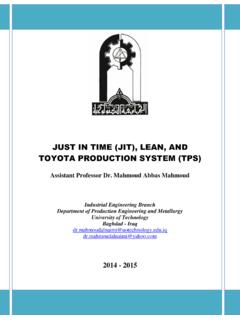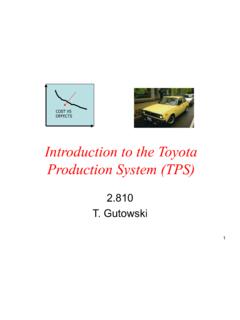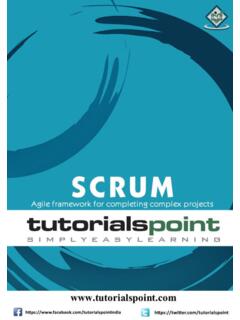Transcription of Basic Lean Glossary 10082019
1 Confidential. Not to be copied, distributed, or reproduced without prior approval. October 8, 20191 Lean Glossary of TermsBASICGLOSSARYO ctober 8, 201925sBuilding Blocks for shop floor discipline and control; Sort, Set in Order, Shine, Standardize, Sustain (Also known as Sort, Sweep, Standardize, Self Discipline, Sustain). Action Workout(Kaizen) 3-5 day team based activity focused on quickly solving problems through physical simulation and visual device (light) or pin-pan-pon that operators use to call attention to an abnormality. The use of this is to request immediate attention and action to the process of separating the work of man and machine characterized by: work not movement; quality built into the process; and visual management.
2 (see Jidoka)CellThe optimal physical layout or machines and manpower for a product or family of products that identifies and eliminates method of conducting single-piece flow in which the operator proceeds from machine to machine (in a counter-clockwise fashion), taking a part from the previous operation and loading it in the next machine. Then taking the part just removed from that machine, checking it and loading it into the following ,..Continuous Flow ProcessingCarrying out one-piece-at-a-time production in order to eliminate stagnation of work (queue) in and between processing steps (see Flow)Cycle TimeThe total time required for a task to be complete. Elements include manual and travel times, automated or machine run done simultaneous to or in conjunction with transportation or conveyance.
3 (1)an assembly is moving down a line while a person is performing work, (2)a person acts as a conveyor carrying a part to the next machine in a Chaku-chakufashion. The main purpose of flow is to quickly and continuously identify and eliminate process of level loading and sequencing the timing of (Just in time) theory of production characterized by (1)single piece flow, (2)producing according to TAKT time, (3)pulling of material from upstream process, keeping inventory at minimum, established Change for the better ; a process quality tool for improvement involving a series of activities whereby instances of waste are eliminated one by one at minimal cost, by workers pooling their ideas and increasing efficiency in a timely manner.
4 It emphasizes manual work operations rather than equipment. (see action workout)KanbanA method/device of pulling from previous processes in order to control material flow, cap inventory levels, and to take pulse of the customer. It serves as: an instruction for when to produce; a tool for visual control against over production and a detection of irregular processing speeds. kanban can be broadly categorized into 2 categories: Production kanban and Pick-up kanban . These can be further stratified into Ordinary, Signal, Transport, and component parts used in a process or build for ease of assembly. ( see material presentation )Lead TimeThe total time it takes the product to go from raw inventory to the finished product.
5 Order to remittance lead time refers to the total time from when an order is placed until the finished product is shipped. Level ProductionOverall leveling in the production schedule of the variety and volume of items produced in a given time period. ( see Heijunka)Machine TimeThe time from machine switch on, processing, to machine returning to original position, during which there is no hands-on work by the TimeThe hands-on time it takes for the worker to perform a Lean GlossaryMaterial PresentationIntroducing material to the line or cell in a manner that is easy and effective for the operator. Usually broken into 3 categories (1)items that are too large to kit (2)items that are too small to kit (3)items that lend themselves to be that have human intelligence built into them, giving them the ability to shut down automatically in the case of an abnormality to stop defective products from flowing into the next process.
6 Jidokameasures are incorporated in the assembly process by use of Andonsand Pin-Pan-Pon; stopping when abnormality is type of waste elements that add no value to the product: Waiting, Transporting, Over production, Excess Motion, Inventory Defects, Human Piece FlowProduction system in which only one part at a time is processed or assembled and the work is verified before being sent along the production line to follow form of Andon that is sounds are designated to certain points on the line. pin-pin-pin repeating sound may be associated with power supply installation, calling attention to it when an abnormality has been proof: usually refers to the use of fail-safe devices in the process in order to prevent defects from occurring and insure quality.
7 When this ingredient is added to automation will yield autonomation. ( see Jidoka)ProcessA series of steps to achieve a desired CapacityMaximum amount of product that can be produced through a process for a given period of Capacity TableIndicates the maximum capacity for parts processing at any one process. Recorded on it are: the amount of time spent in manual work, machine time, setup time, MappingA technique used to follow the detailed flow of a product through a manufacturing Route AnalysisA study of the process and machine sequence for a group of similar parts. It can be used to standardize product flow for ease of cell Quantity AnalysisA study of the quantities demanded of different products produced at a work location.
8 This picture of the volume and variety of products can be used to identify high impact areas to concentrate efforts or identify the need to use process razing to make products more SystemSystem of manufacturing in which each process withdraws the parts it needs from the preceding process when they need them, in the exact standardized amount , ExternalMachine changeover steps that are performed while the machine is processing parts or off-line from production , InternalMachine changeover steps that are performed while the machine is stopped during production company founded by C. Nakao and K. Iwata, former employees of Taiichi Ohno, the creator of the Toyota Production System. The word Shingijutsutranslates as new technology or better way.
9 October 8, 20193 Basic Lean GlossarySMEDS ingle Minute Exchange Die ( , under 10 min) has become a title for the category of improvement devices used in manufacturing to allow for quick change over of machine/fixture OperationsThe combination of people and machines required to accomplish production in such a way as to minimize WIPM inimum (and standardized) amount of work in process required to perform repetitive operations WorkSequence of repeatable tasks that an operator Work SheetShows the outline of work for each worker in a cell. Recorded on it are: Takt time, work sequence, standard WIP, quality checks, safety precautions, Work Combination SheetA table that clarifies how much time is spent doing manual work and traveling at each production process.
10 It is used to examine the range of processes that one worker can take care of within Takt time and the amount of time during which machines are operated automatically. These are recorded to help determinewhat combination of operations are MarketA visual system that has a predetermined amount of inventory and all facets of 5s in order to detect abnormalities. With this system, the shopper from the downstream process can buy from the supermarket. Once the purchase has been made, and material consumed, a signal can be sent to the upstream process to supply more. (see pull)Takt TimeAvailable production time / required productionTPMT otal Productive Maintenance is the total involvement of all employees in a cell to improve the StreamThe specific activities required to design, order, and provide a product from concept to launch order to delivery raw materials to finished Stream MappingThe process of detailing the process of converting raw material to finished goods.
















